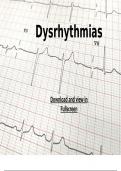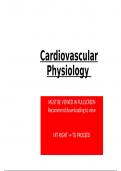Codygulizo
On this page, you find all documents, package deals, and flashcards offered by seller codygulizo.
- 3
- 0
- 1
Community
- Followers
- Following
4 items

Learning to read 12 lead EKGs and abnormal rhythms
This is a combo of 2 presentations. The first covers how to read a 12-lead EKG from the EKG paper itself to what each lead means and views within the heart. It also covers STEMIs and special situations to consider. The 2nd PowerPoint covers abnormal rhythms and their defining characteristics on an EKG.
- Package deal
- • 2 items •
- Understanding and introduction to 12 lead ECG/EKG • Summary
- Abnormal Heart Rhythms • Summary
This is a combo of 2 presentations. The first covers how to read a 12-lead EKG from the EKG paper itself to what each lead means and views within the heart. It also covers STEMIs and special situations to consider. The 2nd PowerPoint covers abnormal rhythms and their defining characteristics on an EKG.

Abnormal Heart Rhythms
This PowerPoint presentation covers abnormal heart rhythms and their defining characteristics on an EKG. The following rhythms are included: Sinus rhythms (brady/tachy), Supraventricular tachycardias (SVT), Afib, Aflutter, premature contractions (PAC, PJC, PVC), Atrioventricular blocks, Pulseless electrical activity (PEA), pacemakers, bundle branch blocks and ventricular arrhythmias (Vfib, Vtac). Recommend viewing my EKG PowerPoint first if you are new to reading EKGs. Recommend viewing in...
- Package deal
- Summary
- • 32 pages •
This PowerPoint presentation covers abnormal heart rhythms and their defining characteristics on an EKG. The following rhythms are included: Sinus rhythms (brady/tachy), Supraventricular tachycardias (SVT), Afib, Aflutter, premature contractions (PAC, PJC, PVC), Atrioventricular blocks, Pulseless electrical activity (PEA), pacemakers, bundle branch blocks and ventricular arrhythmias (Vfib, Vtac). Recommend viewing my EKG PowerPoint first if you are new to reading EKGs. Recommend viewing in...

Understanding and introduction to 12 lead ECG/EKG
This PowerPoint presentation is an introduction to EKG theory and an understanding of how to read a 12-lead electrocardiogram. I break down all 12 leads by their groups and what they analyze, the EKG paper and what it means, and all the timing intervals. You will learn how to identify STEMIs and special scenarios of inferior, posterior, and right-sided STEMIs. You will also learn multiple ways to identify axis deviation (heart shifts within the thorax) by looking at EKGs.
- Package deal
- Summary
- • 23 pages •
This PowerPoint presentation is an introduction to EKG theory and an understanding of how to read a 12-lead electrocardiogram. I break down all 12 leads by their groups and what they analyze, the EKG paper and what it means, and all the timing intervals. You will learn how to identify STEMIs and special scenarios of inferior, posterior, and right-sided STEMIs. You will also learn multiple ways to identify axis deviation (heart shifts within the thorax) by looking at EKGs.

Cardiovascular Hemodynamics/Physiology
This is a PowerPoint presentation on the physiology of blood flow throughout the human cardiovascular system. It also dives into the mechanics of the heart and the cardiac cycle. It explains physical relationships including frank-starling law, cardiac output, the resistance of blood to the diameter of tubes, and many more. EKGs are presented at the end but if you need a more in-depth presentation on EKGs check out my other ones. This topic is very dense and attempts to build on concepts from...
- Presentation
- • 28 pages •
This is a PowerPoint presentation on the physiology of blood flow throughout the human cardiovascular system. It also dives into the mechanics of the heart and the cardiac cycle. It explains physical relationships including frank-starling law, cardiac output, the resistance of blood to the diameter of tubes, and many more. EKGs are presented at the end but if you need a more in-depth presentation on EKGs check out my other ones. This topic is very dense and attempts to build on concepts from...
